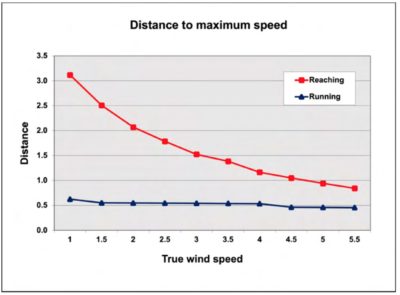TECH TOPICS: The Effects of Being Overweight (your boat that is)
Article by John Henderson
Boat weight is a frequent discussion topic among modelers, and it can be a source of lament, excuses, and bragging rights depending on your racing success that day. More usefully, it should be part of the planning process during design and building. In my club, the Model Sailing Club of the ChesapeakeBay Maritime Museum, several of us have devoted a fair number of emails to the topic during this winter building season. With guidance from Lester Gilbert’s writing, particularly what is found at www.onemetre.net/Build/Accel/Accel2.htm, I will try to quantify the effects of excess weight.
Let us be clear: We are not talking about a boat that is grossly overweight. We are considering weight differences of a few percentage points, say 5% — which means about 12–13 oz in a ~16-lb Vintage Marblehead.
I encourage those interested to read Lester’s complete article at the website listed above. For this short essay, I will cut to the chase. Lester’s spreadsheets estimate drive forces and acceleration. He computes time and distance to reach maximum boat speed as a function of wind speed. His final plot, which I have reproduced below, shows the distance lost by a boat that is a few percentage points heavier from a standing start until the time maximum speed is reached. Note that the units are normalized and intended to reference metric units, but I think we can draw fair conclusions if we think of the vertical axis in terms of meters and the horizontal axis in terms of meters/second. A True Wind Speed of 1 meter/second is about 2 mph. A Lost Distance of 0.045 meters is about 2 in.
We can make a couple of observations, some of which are quite surprising:
- The largest difference occurs when reaching in light air, but even in this case the heavier boat only loses about 2 in when accelerating from a standing start. In a race, we are mostly concerned with distance lost after a tack, which presumably we are exiting at a speed greater than zero, so the loss after a tack is even less than shown in Lester’s plot. Even after multiple tacks up a windward leg, the distance lost by the heavier boat from the act of tacking is likely much less than the distance lost to other factors (bad start, missed wind shift, non-optimum sailing angle or trim, etc.).
- The distance lost on a run is quite small and it is independent of wind speed.
 These results run counter to our generally accepted wisdom regarding the performance penalties of overweight boats. So, what is going on? Note first that the results are stated in terms of distance, not time. A heavier boat indeed takes longer to accelerate, but its top speed will not be much different from the lighter boat. Thus, the lighter boat, even though it reaches its maximum sooner, is not going much faster while the heavier boat is accelerating to its maximum. Furthermore, a large part of the total acceleration time is spent raising the speed from near maximum to actual maximum (i.e., speed changes more quickly at the lower end of the acceleration curve), so the advantage to the lighter boat is small.
These results run counter to our generally accepted wisdom regarding the performance penalties of overweight boats. So, what is going on? Note first that the results are stated in terms of distance, not time. A heavier boat indeed takes longer to accelerate, but its top speed will not be much different from the lighter boat. Thus, the lighter boat, even though it reaches its maximum sooner, is not going much faster while the heavier boat is accelerating to its maximum. Furthermore, a large part of the total acceleration time is spent raising the speed from near maximum to actual maximum (i.e., speed changes more quickly at the lower end of the acceleration curve), so the advantage to the lighter boat is small.

